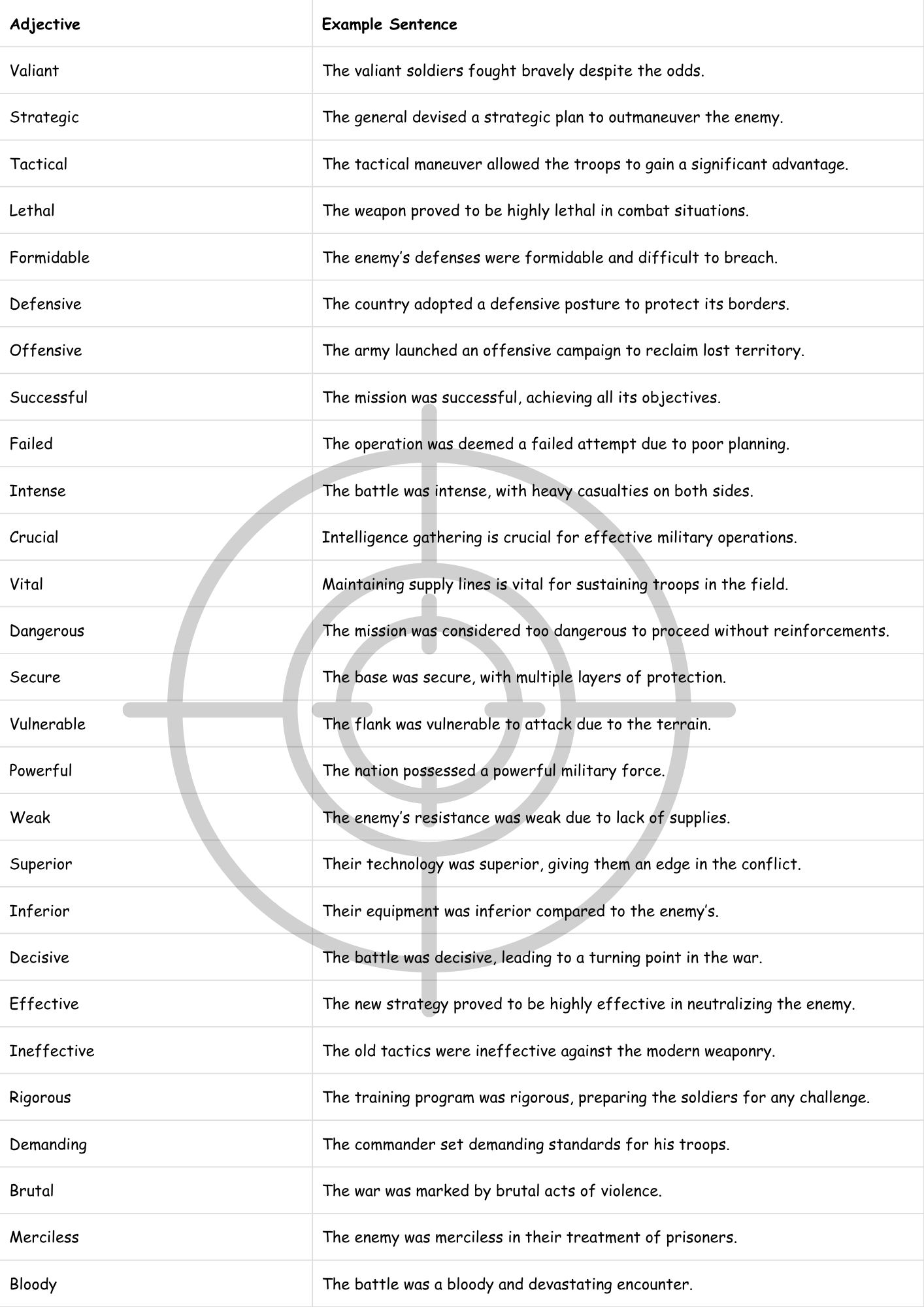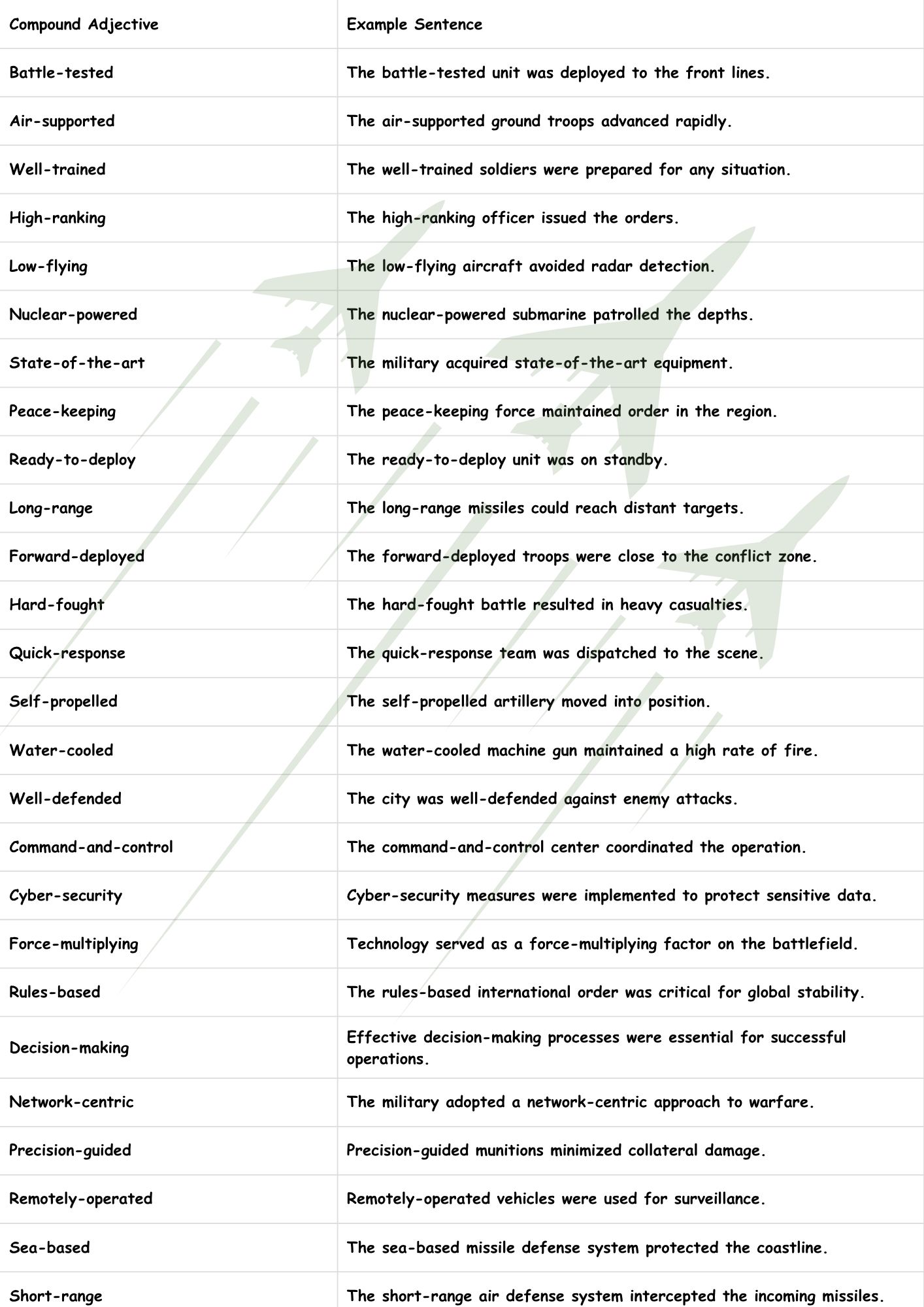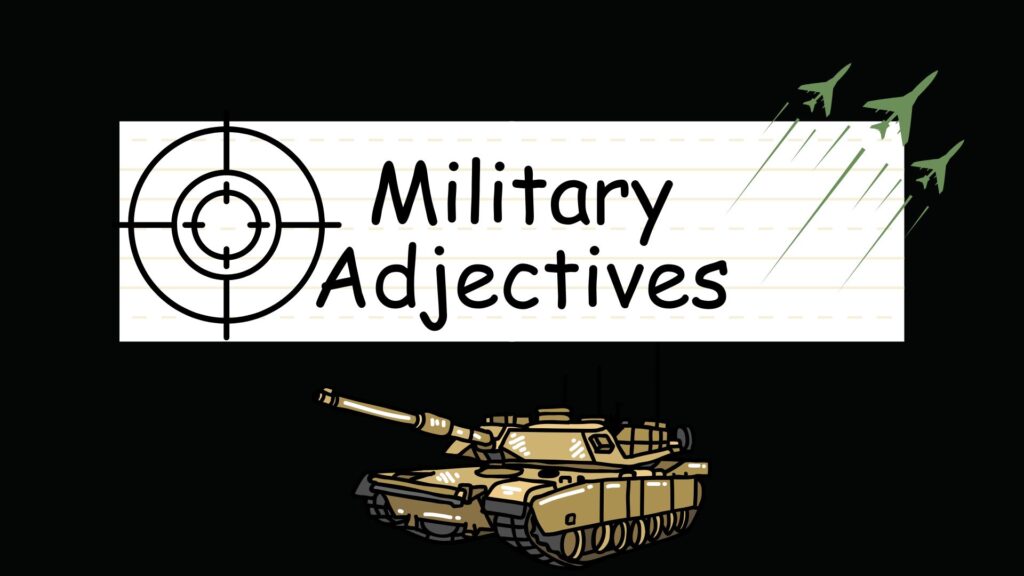Understanding adjectives related to the military is crucial for anyone studying English, especially those interested in history, current events, or military science. These adjectives not only expand your vocabulary but also provide a deeper understanding of specialized language used in specific contexts. This comprehensive guide will explore various types of military adjectives, their usage, and common mistakes, providing you with the knowledge and practice needed to use them confidently.
This article is designed for English language learners of all levels, from beginners seeking to broaden their vocabulary to advanced speakers aiming to refine their understanding of nuanced adjective usage. By the end of this guide, you will be able to identify, define, and correctly use a wide range of military adjectives in your writing and speaking.
Table of Contents
- Definition of Military Adjectives
- Structural Breakdown
- Types and Categories of Military Adjectives
- Examples of Military Adjectives
- Usage Rules for Military Adjectives
- Common Mistakes with Military Adjectives
- Practice Exercises
- Advanced Topics
- Frequently Asked Questions
- Conclusion
Definition of Military Adjectives
Military adjectives are words that describe or modify nouns related to the armed forces, warfare, or military operations. They provide specific details about the characteristics, qualities, or attributes of military-related subjects. These adjectives are essential for precise communication in military contexts, historical analysis, and general discussions about defense and security.
Classification: Adjectives can be classified based on their function. Military adjectives, like other adjectives, can be descriptive, relational, attributive, or predicative. Descriptive adjectives provide information about the qualities of a noun (e.g., strategic, valiant). Relational adjectives indicate a relationship or connection to the military (e.g., naval, aerial). Attributive adjectives are placed directly before the noun they modify (e.g., military strategy). Predicative adjectives follow a linking verb and describe the subject (e.g., The mission was successful).
Function: The primary function of military adjectives is to add detail and specificity to military-related nouns. They help to distinguish between different types of equipment, operations, personnel, or strategies. For example, instead of simply saying “vehicles,” one might use “armored vehicles” to provide a clearer picture.
Contexts: Military adjectives are used in a wide range of contexts, including:
- Military reports and briefings: Describing operations, equipment, and personnel.
- Historical accounts: Detailing battles, strategies, and military leaders.
- News articles: Reporting on current military events and developments.
- Fictional works: Creating realistic and immersive military stories.
- Academic research: Analyzing military history, strategy, and technology.
Structural Breakdown
Military adjectives, like all adjectives, typically precede the noun they modify. However, they can also follow a linking verb, such as “is,” “are,” “was,” or “were,” to describe the subject of the sentence. The structure depends on whether the adjective is used attributively or predicatively.
Attributive Use: In attributive use, the adjective comes before the noun. This is the most common structure. For example:
- Naval ships
- Strategic planning
- Military intelligence
Predicative Use: In predicative use, the adjective follows a linking verb and describes the subject of the sentence. For example:
- The mission was successful.
- The troops are ready.
- The strategy seemed flawed.
Order of Adjectives: When multiple adjectives are used to describe a noun, they generally follow a specific order: opinion, size, age, shape, color, origin, material, and purpose. While this order isn’t always strictly followed, it’s a useful guideline. For example:
- A brave young soldier (opinion, age)
- A large modern military base (size, age, purpose)
Understanding these structural elements is crucial for constructing grammatically correct and clear sentences using military adjectives.
Types and Categories of Military Adjectives
Military adjectives can be categorized based on their meaning and function within a sentence. Understanding these categories can help you choose the most appropriate adjective for a given context.
Descriptive Adjectives
Descriptive adjectives provide information about the qualities or characteristics of military-related nouns. They often express opinions, judgments, or specific attributes.
Examples of descriptive military adjectives include: valiant, strategic, tactical, lethal, formidable, defensive, offensive, successful, failed, intense, crucial, vital, dangerous, secure, vulnerable, powerful, weak, superior, inferior.
Relational Adjectives
Relational adjectives indicate a relationship or connection to the military or a specific branch of the armed forces. They often derive from nouns and specify the type or category of something.
Examples of relational military adjectives include: naval, aerial, ground, military, army, air force, marine, coast guard, infantry, artillery, logistical, operational, national, international.
Attributive Adjectives
Attributive adjectives are placed directly before the noun they modify. Most adjectives can be used attributively.
Examples of attributive use include: military strategy, naval exercises, strategic planning, valiant soldiers, formidable weapons.
Predicative Adjectives
Predicative adjectives follow a linking verb and describe the subject of the sentence. Not all adjectives can be used predicatively, but many common ones can.
Examples of predicative use include: The mission was successful. The troops are ready. The situation is critical. The defenses are vulnerable.
Compound Adjectives
Compound adjectives are formed by combining two or more words, often with a hyphen. They act as a single adjective modifying a noun.
Examples of compound military adjectives include: battle-tested, air-supported, well-trained, high-ranking, low-flying, nuclear-powered, state-of-the-art, peace-keeping, ready-to-deploy, long-range.
Examples of Military Adjectives
This section provides extensive examples of military adjectives categorized by type. Each table includes a variety of adjectives and their usage in sentences to illustrate their meaning and function.
Descriptive Adjectives Examples
The following table showcases examples of descriptive military adjectives used in sentences. These adjectives help to paint a picture of the qualities and characteristics of military actions, personnel, and equipment.
| Adjective | Example Sentence |
|---|---|
| Valiant | The valiant soldiers fought bravely despite the odds. |
| Strategic | The general devised a strategic plan to outmaneuver the enemy. |
| Tactical | The tactical maneuver allowed the troops to gain a significant advantage. |
| Lethal | The weapon proved to be highly lethal in combat situations. |
| Formidable | The enemy’s defenses were formidable and difficult to breach. |
| Defensive | The country adopted a defensive posture to protect its borders. |
| Offensive | The army launched an offensive campaign to reclaim lost territory. |
| Successful | The mission was successful, achieving all its objectives. |
| Failed | The operation was deemed a failed attempt due to poor planning. |
| Intense | The battle was intense, with heavy casualties on both sides. |
| Crucial | Intelligence gathering is crucial for effective military operations. |
| Vital | Maintaining supply lines is vital for sustaining troops in the field. |
| Dangerous | The mission was considered too dangerous to proceed without reinforcements. |
| Secure | The base was secure, with multiple layers of protection. |
| Vulnerable | The flank was vulnerable to attack due to the terrain. |
| Powerful | The nation possessed a powerful military force. |
| Weak | The enemy’s resistance was weak due to lack of supplies. |
| Superior | Their technology was superior, giving them an edge in the conflict. |
| Inferior | Their equipment was inferior compared to the enemy’s. |
| Decisive | The battle was decisive, leading to a turning point in the war. |
| Effective | The new strategy proved to be highly effective in neutralizing the enemy. |
| Ineffective | The old tactics were ineffective against the modern weaponry. |
| Rigorous | The training program was rigorous, preparing the soldiers for any challenge. |
| Demanding | The commander set demanding standards for his troops. |
| Brutal | The war was marked by brutal acts of violence. |
| Merciless | The enemy was merciless in their treatment of prisoners. |
| Bloody | The battle was a bloody and devastating encounter. |

Relational Adjectives Examples
The following table provides examples of relational military adjectives, showing how they connect nouns to specific branches, functions, or aspects of the military.
| Adjective | Example Sentence |
|---|---|
| Naval | The naval fleet patrolled the coastline. |
| Aerial | Aerial reconnaissance provided valuable intelligence. |
| Ground | The ground forces advanced cautiously through the terrain. |
| Military | Military intelligence gathered crucial information. |
| Army | The army engineers built a pontoon bridge. |
| Air Force | The Air Force pilots conducted bombing raids. |
| Marine | The Marine Corps stormed the beach. |
| Coast Guard | The Coast Guard cutter intercepted the smuggling vessel. |
| Infantry | The infantry soldiers marched through the forest. |
| Artillery | The artillery barrage softened the enemy’s defenses. |
| Logistical | Logistical support ensured the troops had supplies. |
| Operational | Operational planning was key to the mission’s success. |
| National | National defense is a top priority for the government. |
| International | International peacekeeping forces were deployed to the region. |
| Strategic | The strategic importance of the location was undeniable. |
| Tactical | The tactical advantage gained proved decisive. |
| Defense | The defense budget was debated in parliament. |
| Combat | Combat training prepared the soldiers for real-world scenarios. |
| Security | Security measures were tightened at the border. |
| Frontline | The frontline troops faced the brunt of the enemy’s attack. |
| Reserve | The reserve units were called up to support the active forces. |
| Intelligence | Intelligence reports indicated an impending attack. |
| Reconnaissance | Reconnaissance missions mapped the terrain ahead of the main force. |
| Supply | Supply convoys delivered ammunition and food to the troops. |
| Communication | Communication networks were crucial for coordinating the operation. |
| Medical | Medical personnel provided care for the wounded soldiers. |
| Engineering | Engineering units built fortifications and cleared obstacles. |
| Aviation | Aviation assets provided air support and transportation. |
Attributive Adjectives Examples
This table illustrates the use of military adjectives in the attributive position, directly preceding the noun they modify.
| Adjective + Noun | Example Sentence |
|---|---|
| Military Strategy | The military strategy focused on a swift and decisive victory. |
| Naval Exercises | Naval exercises were conducted to improve coordination between allies. |
| Strategic Planning | Strategic planning is essential for long-term success. |
| Valiant Soldiers | Valiant soldiers received medals for their bravery. |
| Formidable Weapons | The enemy possessed formidable weapons capable of inflicting heavy damage. |
| Defensive Position | The troops established a strong defensive position on the hill. |
| Offensive Maneuver | The offensive maneuver caught the enemy by surprise. |
| Successful Operation | The successful operation boosted morale among the troops. |
| Failed Attempt | The failed attempt highlighted the need for better intelligence. |
| Intense Fighting | Intense fighting raged for several days in the city. |
| Crucial Information | The crucial information helped to avert a disaster. |
| Vital Supplies | Vital supplies were airlifted to the besieged outpost. |
| Dangerous Mission | The dangerous mission required highly skilled personnel. |
| Secure Communication | Secure communication channels were used to transmit sensitive data. |
| Vulnerable Point | The vulnerable point in the defense was quickly reinforced. |
| Powerful Nation | The powerful nation maintained a strong military presence. |
| Weak Resistance | The weak resistance allowed the invaders to advance rapidly. |
| Superior Technology | Superior technology gave them a significant advantage in the war. |
| Inferior Equipment | Inferior equipment put the soldiers at a disadvantage. |
| Decisive Victory | The decisive victory ended the conflict. |
| Effective Tactics | Effective tactics were implemented to minimize casualties. |
| Ineffective Strategy | The ineffective strategy led to several setbacks. |
| Rigorous Training | Rigorous training prepared the recruits for the challenges ahead. |
| Demanding Commander | The demanding commander pushed his troops to their limits. |
| Brutal Warfare | Brutal warfare left a lasting scar on the nation. |
| Merciless Enemy | The merciless enemy showed no compassion to the civilians. |
| Bloody Battle | The bloody battle resulted in heavy losses on both sides. |
Predicative Adjectives Examples
This table demonstrates the use of military adjectives in the predicative position, following a linking verb and describing the subject.
| Sentence Structure | Example Sentence |
|---|---|
| The mission was… | The mission was successful. |
| The troops are… | The troops are ready. |
| The situation is… | The situation is critical. |
| The defenses are… | The defenses are vulnerable. |
| The soldiers were… | The soldiers were brave. |
| The plan seemed… | The plan seemed flawed. |
| The attack became… | The attack became intense. |
| The location appeared… | The location appeared secure. |
| The enemy seemed… | The enemy seemed formidable. |
| The strategy proved… | The strategy proved effective. |
| The training is… | The training is rigorous. |
| The conditions are… | The conditions are dangerous. |
| The outcome was… | The outcome was decisive. |
| The resistance became… | The resistance became weak. |
| The technology is… | The technology is superior. |
| The equipment was… | The equipment was inferior. |
| The commander is… | The commander is demanding. |
| The actions were… | The actions were brutal. |
| The enemy was… | The enemy was merciless. |
| The battle was… | The battle was bloody. |
| The position is… | The position is defensive. |
| The maneuver was… | The maneuver was offensive. |
| The attempt was… | The attempt was failed. |
| The information is… | The information is crucial. |
| The supplies are… | The supplies are vital. |
Compound Adjectives Examples
This table shows examples of compound military adjectives, formed by combining two or more words to modify a noun.
| Compound Adjective | Example Sentence |
|---|---|
| Battle-tested | The battle-tested unit was deployed to the front lines. |
| Air-supported | The air-supported ground troops advanced rapidly. |
| Well-trained | The well-trained soldiers were prepared for any situation. |
| High-ranking | The high-ranking officer issued the orders. |
| Low-flying | The low-flying aircraft avoided radar detection. |
| Nuclear-powered | The nuclear-powered submarine patrolled the depths. |
| State-of-the-art | The military acquired state-of-the-art equipment. |
| Peace-keeping | The peace-keeping force maintained order in the region. |
| Ready-to-deploy | The ready-to-deploy unit was on standby. |
| Long-range | The long-range missiles could reach distant targets. |
| Forward-deployed | The forward-deployed troops were close to the conflict zone. |
| Hard-fought | The hard-fought battle resulted in heavy casualties. |
| Quick-response | The quick-response team was dispatched to the scene. |
| Self-propelled | The self-propelled artillery moved into position. |
| Water-cooled | The water-cooled machine gun maintained a high rate of fire. |
| Well-defended | The city was well-defended against enemy attacks. |
| Command-and-control | The command-and-control center coordinated the operation. |
| Cyber-security | Cyber-security measures were implemented to protect sensitive data. |
| Force-multiplying | Technology served as a force-multiplying factor on the battlefield. |
| Rules-based | The rules-based international order was critical for global stability. |
| Decision-making | Effective decision-making processes were essential for successful operations. |
| Network-centric | The military adopted a network-centric approach to warfare. |
| Precision-guided | Precision-guided munitions minimized collateral damage. |
| Remotely-operated | Remotely-operated vehicles were used for surveillance. |
| Sea-based | The sea-based missile defense system protected the coastline. |
| Short-range | The short-range air defense system intercepted the incoming missiles. |

Usage Rules for Military Adjectives
Using military adjectives correctly involves understanding the specific contexts in which they are appropriate and adhering to general grammar rules for adjective use. Here are some key rules to follow:
- Placement: As a general rule, place adjectives before the noun they modify (attributive use). For example, “strategic retreat.” However, adjectives can also follow linking verbs (predicative use). For example, “The retreat was strategic.”
- Order: When using multiple adjectives, follow the general order of adjectives: opinion, size, age, shape, color, origin, material, purpose. This order can vary based on context and emphasis.
- Hyphenation: Compound adjectives are usually hyphenated, especially when they precede the noun. For example, “well-trained soldiers.” However, if the compound adjective follows the noun, the hyphen is often omitted. For example, “The soldiers were well trained.”
- Specificity: Choose adjectives that accurately and specifically describe the noun. Avoid using vague or generic adjectives when more precise options are available.
- Context: Consider the context in which you are using the adjective. Some adjectives may have specific meanings or connotations in military contexts that differ from their general usage.
- Formal vs. Informal: Be aware of the formality of the adjective. Some military adjectives are highly technical and appropriate for formal reports, while others are more common in everyday language.
Common Mistakes with Military Adjectives
Even experienced English speakers can make mistakes when using military adjectives. Here are some common errors to avoid:
| Incorrect | Correct | Explanation |
|---|---|---|
| The army was strategic. | The strategy was strategic. | Adjectives should describe nouns. “Army” is a collective noun for soldiers, not a strategy. |
| A naval soldier. | A navy soldier. | “Naval” describes things related to the navy, not a soldier. One would say a ‘navy soldier’ |
| The troops are logistical. | The support is logistical. | “Logistical” describes support or planning, not the troops themselves. |
| An air forced attack. | An air force attack. | “Air force” is a two-word term that functions as an adjective. |
| The mission was intenseful. | The mission was intense. | “Intenseful” is not a word. The correct adjective is “intense.” |
| A well trained general. | A well-trained general. | Compound adjectives before a noun are usually hyphenated. |
| The security is national. | The security is a national concern. | “National” needs a noun to modify in this context, such as “concern” or “issue.” |
| The army is superiority. | The army is superior. | “Superiority” is a noun. The correct adjective is “superior.” |
| The plan was strategically. | The plan was strategic. | “Strategically” is an adverb. The correct adjective is “strategic.” |
| More strategic plan. | A more strategic plan. | Articles (a, an, the) are needed before adjectives modifying singular countable nouns. |
Practice Exercises
These exercises will help you practice using military adjectives correctly. Each exercise focuses on different aspects of adjective usage, from identification to sentence construction and error correction.
Exercise 1: Identifying Military Adjectives
Identify the military adjectives in the following sentences. Underline the adjective and identify its type (descriptive, relational, or compound).
| Question | Answer |
|---|---|
| 1. The naval fleet patrolled the waters. | Naval (Relational) |
| 2. The valiant soldiers fought with courage. | Valiant (Descriptive) |
| 3. The well-trained unit was ready for deployment. | Well-trained (Compound) |
| 4. Military intelligence gathered crucial information. | Military (Relational) |
| 5. The mission was successful despite the challenges. | Successful (Descriptive) |
| 6. The air force pilots conducted bombing raids. | Air force (Relational) |
| 7. The attack was a strategic move. | Strategic (Descriptive) |
| 8. The ready-to-deploy forces are on alert. | Ready-to-deploy (Compound) |
| 9. The ground troops advanced cautiously. | Ground (Relational) |
| 10. The dangerous mission required special skills. | Dangerous (Descriptive) |
Exercise 2: Using Military Adjectives in Sentences
Complete the following sentences by filling in the blank with an appropriate military adjective from the list below.
(strategic, naval, tactical, lethal, military, aerial, ground, valiant, defensive, offensive)
| Question | Answer |
|---|---|
| 1. The _____ forces launched an attack. | Offensive |
| 2. The _____ fleet protected the coastline. | Naval |
| 3. The _____ plan was designed to outmaneuver the enemy. | Strategic |
| 4. _____ intelligence is key to a successful operation. | Military |
| 5. The _____ maneuver helped them gain an advantage. | Tactical |
| 6. The _____ weapon was too dangerous to use. | Lethal |
| 7. The _____ soldiers fought bravely. | Valiant |
| 8. _____ support provided valuable reconnaissance. | Aerial |
| 9. The _____ forces advanced slowly through the forest. | Ground |
| 10. The country adopted a _____ posture to safeguard its borders. | Defensive |
Exercise 3: Correcting Mistakes with Military Adjectives
Identify and correct the mistakes in the use of military adjectives in the following sentences.
| Question | Answer |
|---|---|
| 1. The soldier was naval. | The soldier was in the navy. |
| 2. The strategy was army. | The strategy was military. |
| 3. The mission was intenseful. | The mission was intense. |
| 4. A well train soldier. | A well-trained soldier. |
| 5. The logistical are important. | The logistical support is important. |
| 6. The strategic was good. | The strategy was good. |
| 7. The air forced attack was successful. | The air force attack was successful. |
| 8. The troops are superiority. | The troops are superior. |
| 9. He is a high rank officer. | He is a high-ranking officer. |
| 10. The plan was strategically. | The plan was strategic. |
Advanced Topics
For those seeking a deeper understanding of military adjectives, here are some advanced topics to explore:
- Historical Evolution: Investigate how military adjectives have evolved over time, reflecting changes in warfare, technology, and geopolitical strategies.
- Cross-Cultural Comparisons: Compare military adjectives across different languages and cultures, noting similarities and differences in their meanings and usage.
- Figurative Language: Analyze the use of military adjectives in figurative language, such as metaphors and similes, to create vivid and impactful imagery.
- Political Discourse: Examine how military adjectives are used in political discourse to shape public opinion and justify military actions.
- Ethical Considerations: Consider the ethical implications of using certain military adjectives, particularly those that may dehumanize the enemy or glorify violence.
Frequently Asked Questions
What is the difference between “military” and “militant”?
Answer: “Military” refers to the armed forces of a country or anything related to them. “Militant” describes someone or something aggressive or combative, often in support of a political or social cause.
Can an adjective be both descriptive and relational?
Answer: Yes, some adjectives can function in multiple categories depending on the context. For example, “strategic” can be descriptive (a strategic plan) or relational (strategic importance).
How do I choose the right military adjective for a specific context?
Answer: Consider the specific meaning you want to convey and the relationship between the adjective and the noun it modifies. Use a dictionary or thesaurus to find synonyms and related terms, and pay attention to the connotations of each word.
Are there any military adjectives that should be avoided in formal writing?
Answer: Avoid using informal or colloquial adjectives in formal writing. Stick to precise and objective language, and be mindful of any potential biases or emotional connotations.
What resources can I use to expand my vocabulary of military adjectives?
Answer: Consult military dictionaries, glossaries of military terms, and online resources such as Wikipedia and specialized military websites. Reading military history and current events can also help you learn new adjectives in context.
Conclusion
Mastering military adjectives is an essential step for anyone seeking to enhance their understanding of military terminology, improve their writing and speaking skills, and engage more effectively with military-related topics. By understanding the definitions, structural rules, categories, and usage guidelines outlined in this guide, you can confidently and accurately use military adjectives in a variety of contexts. Remember to practice regularly, pay attention to common mistakes, and continue to explore advanced topics to further expand your knowledge and expertise.



